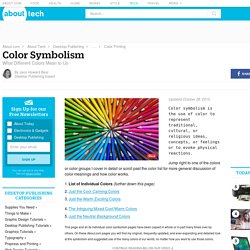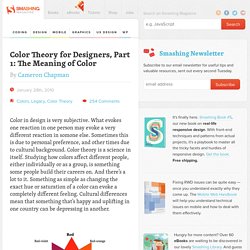

Color Meanings - Explore Palettes and Symbolism - Color Meaning and Colors That Go Together. Updated October 28, 2015.

Color symbolism is the use of color to represent traditional, cultural, or religious ideas, concepts, or feelings or to evoke physical reactions. Jump right to one of the colors or color groups I cover in detail or scroll past the color list for more general discussion of color meanings and how color works. This page and all its individual color symbolism pages have been copied in whole or in part many times over by others.
On these About.com pages you will find my original, frequently updated, and ever-expanding and detailed look at the symbolism and suggested use of the many colors of our world, no matter how you want to use those colors. continue reading below our video Loaded: 0% Progress: 0% Choosing colors based on symbolism can apply to everything from clothing to wall paint to home furnishings. In desktop publishing and design choosing color based on its symbolism applies to print and electronic projects from logos to Web site backgrounds. Color Wheel Pro: Color Meaning.
Red Red is the color of fire and blood, so it is associated with energy, war, danger, strength, power, determination as well as passion, desire, and love.

Red is a very emotionally intense color. It enhances human metabolism, increases respiration rate, and raises blood pressure. It has very high visibility, which is why stop signs, stoplights, and fire equipment are usually painted red. In heraldry, red is used to indicate courage. Red brings text and images to the foreground. Light red represents joy, sexuality, passion, sensitivity, and love. Orange Orange combines the energy of red and the happiness of yellow. To the human eye, orange is a very hot color, so it gives the sensation of heat. Orange has very high visibility, so you can use it to catch attention and highlight the most important elements of your design.
Dark orange can mean deceit and distrust. Yellow Yellow is the color of sunshine. Use yellow to evoke pleasant, cheerful feelings. Color. Color (American English) or colour (British English; see spelling differences) is the visual perceptual property corresponding in humans to the categories called red, blue, yellow, and others.

Color derives from the spectrum of light (distribution of light power versus wavelength) interacting in the eye with the spectral sensitivities of the light receptors. Color categories and physical specifications of color are also associated with objects or materials based on their physical properties such as light absorption, reflection, or emission spectra. By defining a color space, colors can be identified numerically by their coordinates. Because perception of color stems from the varying spectral sensitivity of different types of cone cells in the retina to different parts of the spectrum, colors may be defined and quantified by the degree to which they stimulate these cells. The science of color is sometimes called chromatics, colorimetry, or simply color science. Color Theory for Designers, Part 1: The Meaning of Color - Smashing Magazine.
Color in design is very subjective.

What evokes one reaction in one person may evoke a very different reaction in somone else. Sometimes this is due to personal preference, and other times due to cultural background. Color theory is a science in itself. Studying how colors affect different people, either individually or as a group, is something some people build their careers on. And there’s a lot to it. This is the first in a three-part series on color theory.
Warm Colors Link Warm colors include red, orange, and yellow, and variations of those three colors. Red and yellow are both primary colors, with orange falling in the middle, which means warm colors are all truly warm and aren’t created by combining a warm color with a cool color. Red (Primary Color) Link Red is a very hot color. Red can be associated with anger, but is also associated with importance (think of the red carpet at awards shows and celebrity events). Outside the western world, red has different associations. Examples.